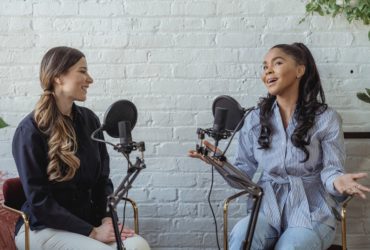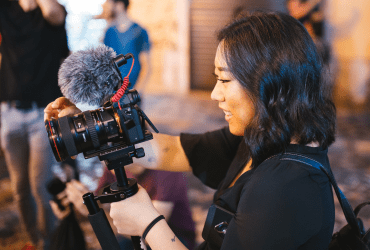By Eric Ferrero, Executive Director
It’s been six months since Jane C. Hu’s deeply reported investigation on public health officials being hounded out of their jobs by right-wing extremists was published, and I still talk about her story nearly every week. It’s one of those stories that sticks with you – partly because it’s even more relevant now than when it was published.
Hu spent nearly a year digging into the network of militias and other extremists in the Western U.S. who have harassed and threatened scores of public health officials during the pandemic. She reported that more than 250 public health officers and board members nationwide have been pushed out of their jobs during the pandemic. She interviewed several of them, and their experiences are haunting.
I talked with Hu about how she reported this extraordinary story, her advice for other journalists investigating militias, the role of long-form journalism in nonprofit outlets and how the science and politics beats have converged.
Q: The individual anecdotes in your story are chilling: A 12-year-old calling his mom at work in terror of protestors outside of the house, strobe lights flashing through the window of a family’s home, protestors blaring clips from the movie “Scarface” through bullhorns outside a public health official’s house at night, and more. A lot of these former health officials probably shun the spotlight now; how did you find them and persuade them to share their stories?
I sent a lot of unanswered emails and made many unreturned cold calls! I knew I’d need to be patient, to build trust with sources, and to accept that many sources would not want to speak on record.
I initially had a hard time finding contact information for Tamalee St. James Robinson, who became a central figure in the story. I decided to switch gears and just focus on understanding what was going on in the community by talking with as many people as possible, which really paid off in the end. During a call with a local school principal, I learned she had actually honored Robinson with an award, because the two had worked closely on COVID protocols for local schools and she knew Robinson had been attacked by other folks in the community. At the end of our conversation, she offered to connect me with Robinson. I think the personal connection really helped, and after a couple get-to-know-you phone calls, Robinson was willing to go on record in an in-person interview. (It also helped that she had retired — retired folks often make the best sources, because they’re full of expertise and can speak more freely.)
Q: Connections among militia members and other extremists can be notoriously difficult to map and track. How did you connect so many dots in this story, and what advice do you have for other investigative journalists who are trying to identify connections like this?
The first thing I’d recommend is talking with experts. My sources at the Institute for Research and Education on Human Rights (IREHR), The Idaho 98%, and the Montana Human Rights Network have been closely tracking militia activity in their communities. They provided invaluable insights about how different people and groups have been connected over the last couple decades.
The second thing: set up ways to passively track these networks to help connect the dots in real time. I set up Google alerts for specific people or groups, and joined some of the groups on social media sites like Facebook and Telegram that extremists frequented. I also read as much local reporting as I could for background — big shoutout to reporters from Boise Public Radio, the Idaho Statesman, and the Flathead Beacon.
Q: You’re one of dozens of our grantees who receive free legal assistance through our partnership with the Reporters Committee for Freedom of the Press. What was that process like, and how did their collaboration help strengthen your story?
Working with RCFP gave me confidence that every claim and fact in my piece was airtight. While my reporting was still in progress, I began meeting with RCFP staff so that we were on the same page about what kinds of evidence and records they needed for legal vetting. Once my first draft was in, they did background research on the legal histories of people and groups I mentioned in the piece: who has been sued, who is litigious, and what would be prudent to mention about them given their history? In later drafts, RCFP did a close read and suggested places in the piece to include additional context, places to consider rephrasing to avoid legal issues, and items to double- or triple-check in the fact-check process.
Q: Your story underscores something that several journalists have told me recently, which is that it’s getting harder to distinguish the science beat from the politics beat, given how much health and science have been politicized. As a longtime science reporter, do you see this as a permanent shift or something that’s spiked during a unique moment in history?
I hope it’s not too much of a cop-out to say I think both things are true. On the one hand, science and politics have always been intertwined. The Tuskegee experiments were a clear reflection of the social politics of (overwhelmingly white and male) scientists: that it was permissible to experiment on Black men. Anti-nuclear protests have waned and waxed over the years in response to geopolitics. We’ve seen in the last few years how Trump’s border wall has disrupted hundreds of species’ habitats.
But on the other hand, this is also a unique moment. Global pandemics don’t come around that often, and politics have become more polarized than ever. That’s supercharged many of the political debates that touch on science, but that’s especially true of COVID, since it’s at the front of our collective minds. Complicating all of this is the proliferation of misinformation: often, it seems people are working with a different set of default assumptions about the facts. I saw this kind of misinformation often in the anti-COVID restriction groups I monitored for my piece. Social media really amplifies it, and even builds community around it. That makes misinformation so much trickier to address, because calling out these untruths isn’t just about facts; it makes people feel like their identity and social community are under attack. In light of all this, science journalism is more necessary than ever: it serves the dual purpose of bringing facts and truth into public understanding of the pandemic, and documenting the current moment for posterity.
Q: This story was published in High Country News, the nonprofit magazine covering the Western U.S. that was just named a finalist for the prestigious American Society of Magazine Editors award for General Excellence, Special Interest. How is the role of outlets like HCN evolving in this changing media landscape?
The hallmark of a HCN story is a strong sense of place, and I’ve always appreciated that about the magazine. That grounding allows the reader to understand why an issue actually matters to a community — and it’s often also an opportunity to understand how what’s happening in this one community represents larger trends affecting the Western U.S., or the country as a whole.
That’s an important lens to report from, especially in the current media landscape; it fills a space national and local publications aren’t always set up to tackle. National publications often take a wider lens, and often don’t cover places in the Western U.S. with as much nuance as it deserves. And on the other end of the spectrum, local publications are being bought out by predatory hedge funds, and may not have the budget for stories on science and health, or investigative longform work. I hope local publications surge back, and I know national desks are working hard at providing more nuanced coverage, but non-profit publications like HCN that are already doing that kind of work are essential in telling stories other outlets aren’t tuned into.




